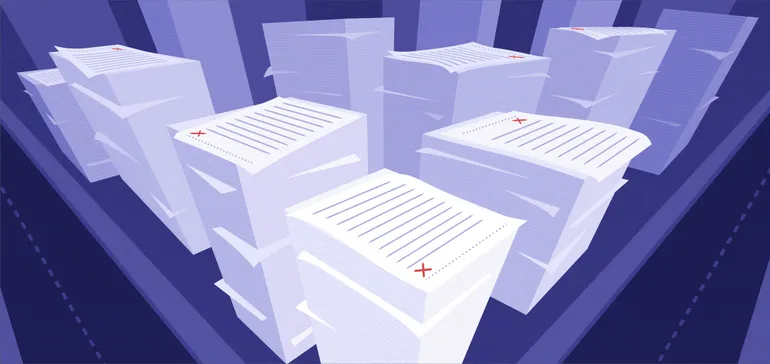This feature is a part of “The Dotted Line” series, which takes an in-depth look at the complex legal landscape of the construction industry. To view the entire series, click here.
Flow-down clauses are a ubiquitous part of the agreement between prime contractors and subcontractors, to the point that parties often sign them without giving them a careful read.
But they’re not always as effective as they could be, especially when misunderstood or under-explained, according to attorneys.
And while these clauses can be exhaustive — government construction contracts can be especially cumbersome — they are rarely encompassing enough to protect GCs from the actions of subs who fall off track.
How flow-downs work
Flow-down clauses are blanket provisions that ensure the terms and conditions agreed to by a GC and owner apply to subcontractors as well. It’s a way for a general contractor to manage risk and reduce the chance of disputes.
“Essentially all of the obligations that are owed from the general contractor to the owner are now mirrored to subs,” said attorney Phillip Parham, associate at Jones Walker in Atlanta.

Phillip Parham
Courtesy of Jones Walker
While precisely which obligations are flowed down can vary, in general they encompass nearly every aspect of the prime agreement between the owner and general contractor, Parham said.
“In this situation, generally speaking, the insurance coverage terms would flow down, the requirement to follow state and federal laws would flow down, and many others,” he said.
That could also include responsibility to conduct on-site investigations about the project’s site conditions, length and breadth of warranty that the subcontractor is required to provide, liquidated damages obligations and even the scope of the subcontractor’s indemnification obligations toward the general contractor, he added.
Although flow-down clauses are standard in contracts between GCs and subs, they shouldn’t be the only legal protection for prime contractors, lawyers say. Relying on blanket flow-down clauses is like sending a soldier into battle with just a helmet, said Parham.
“The flow-down provision in and of itself is not enough to address all the circumstances that may happen between the subcontractors and GC that trigger obligations from the contractor to the owner,” he said.

William Wilson
Courtesy of Robinson+Cole
But perhaps due to the fact that they are pretty much standard, subcontractors also often don’t read or understand the responsibilities that flow-down clauses foist upon them, said William Wilson, a commercial lawyer at Robinson+Cole based in Hartford, Connecticut.
“They just sign it,” he said, which can lead to problems for both the sub and GC when a conflict arises.
Potential problem areas
If a sub doesn’t understand its responsibilities to alert the GC of a possible delay, for example, the GC may not then notify the owner within the timeframe stipulated in their contract, said Parham. That can lead the GC to being on the hook for the delay.
There are some other common areas where GCs may be tripped up on a flow-down clause if they’re not tailored to the specific project, he added.
The most common is inconsistent notice provisions.
For example, a GC may be obliged to notify an owner of any claims for additional compensation within seven days of the event that causes the claim. But the subcontractor’s flow-down clause might say the requirement is 10 days. Now what?
Another instance might be when a flow-down clause includes a 48-hour notice period. But what about an event that happens on a Friday? Are the sub and GC negotiating over the weekend to present to the owner on Sunday?
“You’ve got a really big area of exposure there,” said Parham. “It’s a two-front war where you’re liable to the subcontractor but the owner is no longer liable.”
How GCs can protect themselves
GCs can take some steps to make sure that, if a dispute comes up, they are protected beyond the provisions of the flow-down clause.
“Having litigated a lot of these contract cases, it can be confusing when you just say ‘We’re going to incorporate all the terms of the prime contract,’” said Wilson. “They often conflict, and they’re not clear on who’s responsible for what, and whether that would extend the GC’s responsibilities to the sub.”
For example, a dispute resolution provision in the prime contract might call for arbitration, whereas the subcontract could call for litigation.
Contractors should look for those types of misalignments upfront, so they’re not arguing over them later, when a dispute has already created tension between the parties. “Better to resolve it all in one venue if possible,” Wilson said.
‘Order of priority’
Parham also recommends that GCs pay careful attention to what’s called “the order of priority” listed in documents. That language clarifies which clauses or items take precedence over others. For example, a tailored amendment to a form contract might have a higher priority than the original, boilerplate language.
Also make sure the flow-down provisions from the prime contract and subcontract agree. That’s critical for ensuring your subs understand what you expect of them.
“So where a flow-down clause exists in a subcontract, a subcontractor would have to review both the subcontract itself and the prime contract to understand the entire scope of its obligations toward the general contractor,” he added.
That doesn’t mean conflicts won’t happen. “There’s still going to be disputes,” Parham said, but making sure an order of priority is in place puts a GC in a better spot.
Mandatory flow-downs in federal contracts
GCs who are doing federal government work, however, should keep in mind that they often can’t tailor the flow-downs set out in their contracts.
Instead, they and their subs are bound by the flow-down clauses set out in GSAR 52.244-6, which is a federal acquisition regulation required by subcontracts for commercial products and services.

Merle DeLancey
Courtesy of Blank Rome
Some clauses might not seem relevant to the job at hand, but they are still required, said attorney Merle DeLancey, partner at Blank Rome based in Washington, D.C.
For example, one clause requires privacy training for contractors performing private security functions outside of the United States, which is included even on jobs happening within the country.
“That’s a mandatory flow-down and it will have nothing to do with your job,” Delancey said. But if a GC and its subs (and their subs) want to do government work, they need to agree to it.
GCs can make sure their subs understand that such clauses are mandatory even if they will never affect their jobs — and that the GC can’t negotiate with the prime, because the prime is the U.S. government.
“You have to read those pretty closely because you may have just bought yourself some compliance obligations that you normally wouldn’t have,” Delancey said.

